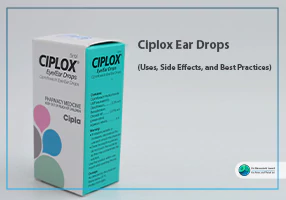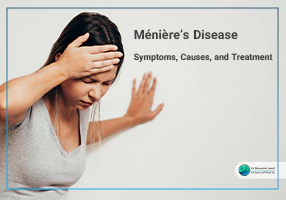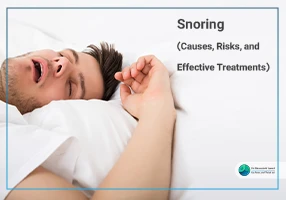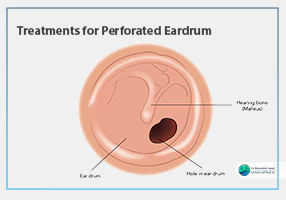Treatments for Perforated Eardrum: A Comprehensive Guide
A perforated eardrum, or tympanic membrane rupture, is a tear in the thin tissue separating the outer and middle ear. This condition can cause pain, hearing loss, and increased infection risk. Understanding treatment options, from natural healing to surgery, is essential for recovery. This guide provides a detailed overview of managing a perforated eardrum effectively.
![]() Causes of Eardrum Perforation
Causes of Eardrum Perforation
Perforations can result from ear infections, trauma (e.g., from cotton swabs), pressure changes (e.g., during flying), or loud noises. Infections like otitis media cause fluid buildup, leading to rupture, while trauma can directly tear the eardrum. Identifying the cause helps determine the best treatment approach.
Symptoms to Recognize
Common symptoms include sudden ear pain, hearing loss, tinnitus, and sometimes discharge or dizziness. Severe cases may involve bleeding or persistent discomfort. Early recognition of these signs prompts timely medical intervention, preventing complications like chronic infections.
Natural Healing Process
Many perforated eardrums heal spontaneously without intervention, especially small tears caused by infections. Proper care during this period is crucial to support healing and prevent complications. Natural healing is most effective for minor perforations under medical supervision.
Conditions for Spontaneous Healing
Small perforations (less than 2 mm) typically heal within 6–8 weeks if the ear remains dry and infection-free. Avoiding water exposure and trauma supports this process. Regular ENT checkups monitor progress and ensure no underlying issues persist.
Care During Healing
Keep the ear dry by using earplugs during bathing or swimming. Over-the-counter pain relievers like acetaminophen or ibuprofen can manage discomfort. Avoid inserting objects into the ear, as they can disrupt healing or introduce bacteria.
Medical Treatment Options
 When natural healing is insufficient, medical interventions can address infections or promote recovery. These treatments are tailored to the perforation’s cause and severity. Always consult an ENT specialist before starting any medication.
When natural healing is insufficient, medical interventions can address infections or promote recovery. These treatments are tailored to the perforation’s cause and severity. Always consult an ENT specialist before starting any medication.
Antibiotic Therapy
- For bacterial infections, oral antibiotics like amoxicillin or ear drops like ofloxacin may be prescribed.
- Drops are only safe with a confirmed intact eardrum, as they can harm the middle ear if it’s perforated.
- Antibiotics reduce infection, allowing the eardrum to heal more effectively.
Adjunctive Treatments
Some studies suggest using gelatin sponges or hyaluronic acid patches to support healing in larger perforations. These therapies are applied by specialists and may reduce recovery time. Avoid steroid drops unless prescribed, as they can delay healing in some cases.
Surgical Interventions
Larger or chronic perforations may require surgical repair to restore eardrum function and prevent complications. Surgical options are highly effective but involve specific considerations for recovery.
Myringoplasty
Myringoplasty uses a tissue graft (often from the patient’s body) to patch the eardrum. Performed under local or general anesthesia, it’s suitable for larger perforations. Recovery takes 4–6 weeks, with restrictions on water exposure and physical activity.
Tympanoplasty and Tubes
- Tympanoplasty repairs the eardrum and damaged middle ear structures, ideal for chronic infections or hearing loss.
- Tympanostomy tubes may be inserted to drain fluid and prevent future perforations.
- Post-surgery care includes avoiding loud noises and regular follow-ups with an ENT specialist.
Preventing Complications
 Untreated perforations can lead to chronic infections, hearing loss, or cholesteatoma (abnormal skin growth). Preventive measures and timely treatment reduce these risks significantly.
Untreated perforations can lead to chronic infections, hearing loss, or cholesteatoma (abnormal skin growth). Preventive measures and timely treatment reduce these risks significantly.
Long-Term Risks
Chronic perforations increase infection risk, potentially leading to mastoiditis or permanent hearing damage. Regular ENT visits detect issues early, preventing progression. Prompt treatment of ear infections is critical to avoid further eardrum damage.
Preventive Strategies
Protect ears from loud noises with earplugs or earmuffs. Avoid smoking, as it impairs healing, and maintain good hygiene to reduce infection risk. A nutrient-rich diet supports tissue repair and immune function.
Frequently Asked Questions
Yes, small perforations often heal within 6–8 weeks with proper care, such as keeping the ear dry. Consult an ENT specialist for monitoring.
Surgery is recommended for large or chronic perforations that don’t heal naturally or cause significant hearing loss.
Surgery is recommended for large or chronic perforations that don’t heal naturally or cause significant hearing loss.
Avoid ear trauma, treat infections promptly, and use ear protection in noisy environments or during pressure changes.
Related Articles
Online Consultation, Directly with Dr. Saeedi
Ask your question via WhatsApp, and if you wish, Send your photo for a more accurate assessment.
Free Consultation on WhatsApp

 Causes of Eardrum Perforation
Causes of Eardrum Perforation



